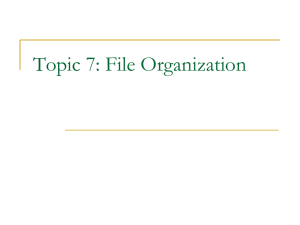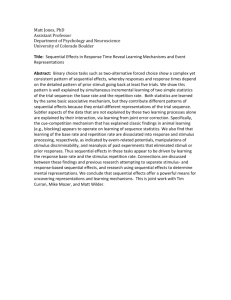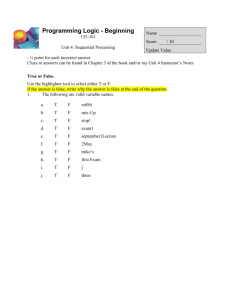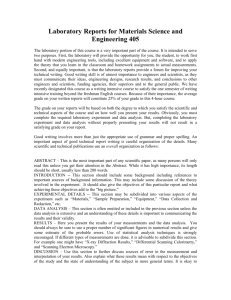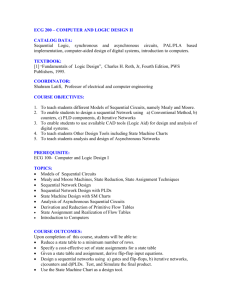AN ASYMPTOTIC DESIGN OPTIMAL of
advertisement
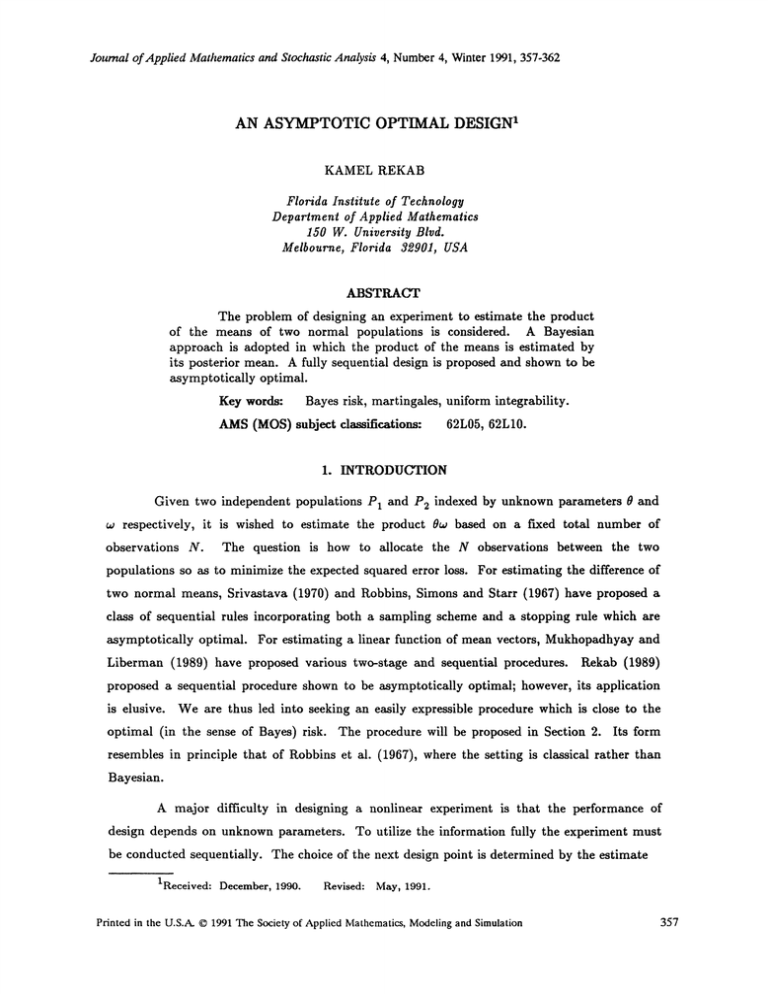
Journal of Applied Mathematics and Stochastic Analysis 4, Number 4, Winter 1991, 357-362
AN ASYMPTOTIC OPTIMAL DESIGN
KAMEL REKAB
Florida Institute
of Technology
Department of Applied Mathematics
150 W. University Blvd.
Melbourne, Florida 3901, USA
The problem of designing an experiment to estimate the product
of the means of two normal populations is considered. A Bayesian
approach is adopted in which the product of the means is estimated by
its posterior mean. A fully sequential design is proposed and shown to be
asymptotically optimal.
Key words: Bayes risk, martingales, uniform integrability.
AMS (MOS) subject classifications:
62L05, 62L10.
1. INTR,ODUCION
Given two independent populations
P1 and P2 indexed by unknown parameters/9 and
product 0w based on a fixed total number of
observations N. The question is how to allocate the N observations between the two
populations so as to minimize the expected squared error loss. For estimating the difference of
two normal means, Srivastava (1970) and Robbins, Simons and Starr (1967) have proposed a
class of sequential rules incorporating both a sampling scheme and a stopping rule which are
w respectively, it is wished to estimate the
asymptotically optimal. For estimating a linear function of mean vectors, Mukhopadhyay and
Liberman
(1989) have proposed
various two-stage and sequential procedures. Rekab
(1989)
proposed a sequential procedure shown to be asymptotically optimal; however, its application
is elusive. We are thus led into seeking an easily expressible procedure which is close to the
optimal (in the sense of Bayes) risk. The procedure will be proposed in Section 2. Its form
resembles in principle that of Robbins et al.
(1967), where the setting
is classical rather than
Bayesian.
A major difficulty in designing
a nonlinear experiment is that the performance of
design depends on unknown parameters. To utilize the information fully the experiment must
be conducted sequentially. The choice of the next design point is determined by the estimate
1Received:
December, 1990.
Revised:
May, 1991.
Printed in the U.S.A. (C) 1991 The Society of Applied Mathematics, Modeling and Simulation
357
358
KAMEL REKAB
of the unknown parameters based on the observations made to date.
To formalize the problem, suppose that 0 and
w are independent random variables
N(/, l/r)
N(, l/s). Given 0, w,
let Xx,X,... Y, Y,... be independent, with X
N(0, 1) and
N(w, 1). Let n
m denote respectively the number of Xs and Ys sampled up to stage k Let .Tj =
r(X,... ,Xj; Y,
Y). An allocation rule will be a stochastic process ,4 = {(n, m)},>_
which have (prior) normal distributions, say 0
on
Af that increases n
or
m by
1 at stage k, and satisfies
{(n,, m) -(j,l),(n+x,m+)
for all k
EAf, j E A/’,l Af. Let 5v = ’(A)
Then it follows that
of allocation rules
Let
’
0
(j + 1,/)} e
{A" AN {(n,m)
(j,/)}
.T’j,t Vj, l}.
is a canonical filtering. A sequential procedure will be a sequence
{(N, AN)}N>I.
#j be the posterior mean
of
given X1,..., Xj that is
"’ + E=, x,
for j
= 1,
Similarly let uj be the posterior mean of w given Yx,..., 1 ;that is
8/2
for j- 1,
Ei=I Y/
-"j+s
Then
e, l&
N(p,,
1
n -t- r
x
N(m,
1
mk
+’s )"
The study proceeds until stage N (fixed). To simplify the notation, nN and mN are denoted
by n and m. Now consider the problem of estimating the product 0w with squared error
loss. It is well known that the Bayes risk is minimized by taking the posterior means as
estimates. Then
()- E
Rekab
(1990)
m+’ +"m
+
+ (+ )(’ 4 S)
derived the following result"
Td(P) >-
Io I) + o(1/N)
N+r+ s
E(I 0 +
An Asymptotic Optbnal Design
as N
---,
+cx
359
with equality if and only if the following three conditions are satisfied"
(i) m, n
(ii)
(iii)
In the next section
+
I01
rn
’*
N
#2n m
in probability as N --.
in probability as N
10-i-+ I i
um--n
and
+oo
are uniformly integrable.
an easily expressible procedure is proposed.
2.
THE PROCEDURE.
One way of solving the problem is to estimate the unknown parameters 0 and w at each
stage. A procedure of this kind is referred to as the fully sequential procedure. To derive
the fully sequential procedure 7)*, observe that for all k
1
m:
Since #n and
um,
+
s
nk+r
are uniformly integrable
}
martingales, one could minimize the above
equality by setting
n+r
lum l"
With a motivation to move m+,
toward the ideal value I,,kl one may define a sequential
nk+r
procedure 79" as follows: Start by taking one observation from each population. Then at
stage k + 1 choose Y if
and X otherwise.
Theorem 2.1 Let 79* be defined as above. Then
(P’) =
E,(,I, 0 + w, [), + o(1/N)
N + r+ s
KAMEL REKAB
360
3. PROOF OF THEOREM 2.1
As it was mentioned previously, one needs to show that the three conditions listed in
Section 1 are verified.
Proof: To show condition (i), note that the proposed sequential procedure can be
rewritten as follows: choose Y at stage k + 1 if
(3.1)
Suppose that
hand, since k
nk is
bounded. Then the right hand side of (3.1) is bounded. On the other
cx, the left hand side of (3.1) goes to infinity with probability one. Hence,
we have a contradiction.
k
By the same argument it follows that
c almost surely as
mk
+oo. To show condition (ii) let
’
k"= sup{/< k"
Then k’, k"
!’,’
+,
____m’
<
+r
ni
sup(/<
mi
Vmi
>
ni+r
[Vmi
}
’}.
+oo as k --+ +oo. Now
mk+s
nWr
=
<
+s
n+r
1
m,
n+r
---,
<
1
+s
nk, + r
n+r
m,
q-
Similarly,
m+s
m+s =
m,,
n,,
>
m,,
,,,’+,.+i
+ s (1-
+r
(1-
m,,
+s
1
n,,
+r+ 1"
n,,
+r+1
Condition (ii) follows easily by letting k go to infinity, since
martingale convergence theorem. Since
nk+r
<
Vm,
+2,
)"
un
0 and vm,
w by the
An Asymptotic Optimal Design
361
it follows that
N+r+s 2 < max
n+r ’rn
-,
Uniform integrability of N
sup
N
Since Pnum
2
#n,rn,
+2’m
will follow if we establish
E{(rnax
ttnk rnk
I) ’} < cx) for some
= E(eI&), then p,um is
a submartingale.
a
>
1.
By Doob’s inequality for
nonnegative submartingales,
sup E {
N
Thus, uniform integrability of
,n+,
,
(rnax
-h-Urger 2
is established. A completely analogous argument for
yields the theorem.
ACKNOWLEDGMENT
I am grateful to the referee for many helpful comments and remarks, which led to an
improvement of an earlier version of this paper.
BIBLIOGRAPHY
[1] Doob, J. (1953). Stochastic Processes. John Wiley & Sons, Inc. New York.
[2] Ford, I. and
Silvey, S. D. (1980). A sequentially constructed design for estimating a
nonlinear parametric function. Biometrika. 67, 381-388.
[3] Mukhopadhyay, N. and Liberman, S. (1989). Sequential estimation of a linear function
of mean vectors. Sequential Analysis. 8, 381-394.
[4] Rekab, K. (1989).
Asymptotic efficiency in sequential designs. Sequential Analysis. 8,
269-280.
[5] Rekab, K. (1990). Asymptotic optimality of experimental designs in estimating a product
of means. J.A.M.S.A. 3, 15-25.
[6] Robbins, H., Simons, G.,
and Starr, N. (1967). A sequential analogue of the BehrensFisher problem. Ann. Math. Star. 38, 1384-1388.
[7] Srivastava, M.S. (1970). On
the sequential analogue of the Behrens-Fisher problem. J.
Roy. Statist. Soc., B 32, 144-148.

